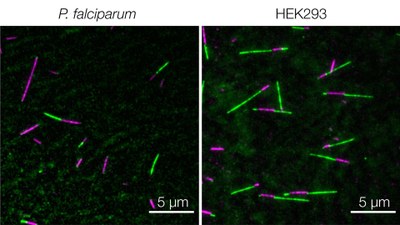Attack on the malaria parasite cytoskeleton

Dynamic microtubules can be visualised using total internal reflection
fluorescence (TIRF) microscopy, which can be used to characterise
differences between parasite (left) and mammalian HEK293 (right)
tubulin. This led to the identification of compounds with selective
toxicity against parasite microtubules.
Images: Simone Reber / IRI Life Sciences
Despite all efforts, malaria remains one of the deadliest diseases with an estimated 240.000.000 cases and more than 600.000 fatalities in 2020 alone. Sadly, most malaria deaths (60-75 per cent) still occur in children aged under 5 years (World Malaria Report 2021). Thus, reducing the burden of malaria cases and deaths remains a global aim and medical challenge.
Like most eukaryotic cells, Plasmodium falciparum, the causative agent of malaria, relies on its cytoskeletal filaments, including microtubules, for proliferation, growth, and transmission. Indeed, microtubules and their molecular building block tubulin have gained outstanding importance as targets for drug development, in particular for a variety of cancers. Despite the remarkable successes in chemotherapies, the development of parasite-specific tubulin drugs has been neglected. Although P. falciparum and human tubulin are very similar, molecular biologist and first author of the study William Hirst and colleagues reasoned that the tubulins were sufficiently divergent to identify compounds that would selectively disrupt parasite microtubules but would keep the human cytoskeleton intact.
Researchers can now screen for parasite-specific inhibitors
So far, the limitation for testing this idea was the availability of P. falciparum tubulin. In this study, Hirst and colleagues from Humboldt-Universität zu Berlin, Freie Universität Berlin and the Australian National University in Canberra, succeeded for the first time in the purification and characterization of functional Plasmodium tubulin from infected human red blood cells. Now that functional parasite and human tubulin were available, the researchers could pursue their idea and screen for parasite-specific inhibitors. They tested compounds that had already been suspected to specifically target Plasmodium microtubules, but for which the exact molecular mechanism of parasite growth inhibition remained unknown.
Among the various compounds tested, two compounds exhibited selective toxicity towards parasite microtubules but - importantly - did not inhibit human microtubule growth. Simone Reber, head of the research group, is very enthusiastic about this success. “Our ability to now specifically screen for compounds that disrupt protozoan microtubule growth without affecting human microtubules provides an exciting opportunity for the development of novel, much-needed anti-malarials.” she says.
This research was funded by the Alliance Berlin-Canberra “Crossing Boundaries: Molecular Interactions in Malaria” which is co-funded by grants from the Deutsche Forschungsgemeinschaft (DFG) and the Australian National University (ANU) for the International Research Training Group (IRTG) 2290 at the IRI Life Sciences. It supported William Hirst and Dominik Fachet and enabled their stay in the lab of Kevin Saliba at the ANU, Canberra.
Original publication
William G. Hirst, Dominik Fachet, Benno Kuropka, Christoph Weise, Kevin J. Saliba, Simone Reber. Purification of functional Plasmodium falciparum tubulin allows for the identification of parasite-specific microtubule inhibitors. Current Biology (2021). DOI: https://doi.org/10.1016/j.cub.2021.12.049
About IRI Life Sciences
The Integrative Research Institute (IRI) for the Life Sciences was founded in 2013 as part of the Excellence Initiative by Humboldt-Universität zu Berlin together with Charité-Universitätsmedizin Berlin and the Max Delbrück Center for Molecular Medicine in the Helmholtz Association (MDC). The researchers at IRI Life Sciences conduct interdisciplinary basic research. They use innovative methods to investigate the cellular causes of cancer and infectious diseases, for example.
Further information
Contact
Robert Kircher-Reineke
Media and Communications
IRI Life Sciences
Phone: +49 (0)30 2093-47903
robert.kircher-reineke@hu-berlin.de
